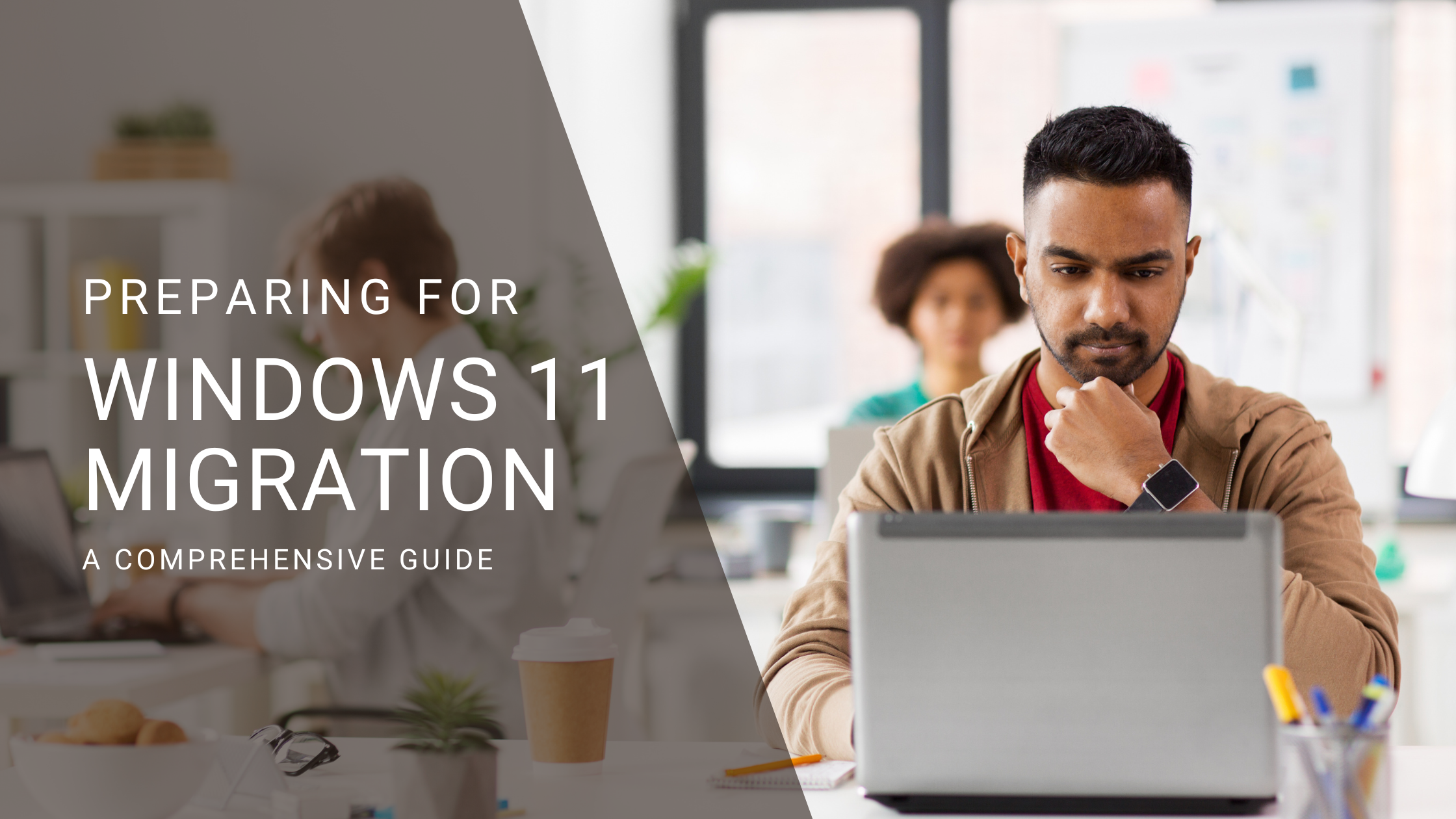
As the end of support for Windows 10 approaches on October 14, 2025, organizations must proactively plan their transition to Windows 11 to maintain security, performance, and access to new features. Whether managing a small business or a large enterprise, understanding what needs to be done and how to do it is essential to a successful Windows 11 migration. This guide covers the key aspects of preparing for and executing the migration, from assessing your current system setup to rolling out the upgrade and providing post-migration support. All key steps in ensuring a smooth and successful Windows 11 migration.
Why You Need to Migrate to Windows 11
The primary reason for migrating to Windows 11 is that Windows 10 will no longer receive support after October 14, 2025 and will become a legacy system. Without continued support, your systems will be at greater risk of cyber threats, software incompatibilities, and system vulnerabilities. Once the migration takes place, this means no more security patches, performance updates, or bug fixes - leaving your IT infrastructure exposed to potential vulnerabilities and operational inefficiencies. Running an outdated, unsupported operating system can also lead to compliance issues, especially for organizations in regulated industries such as finance, healthcare, or government services.
Windows 11, however, brings a range of security enhancements, system optimizations, and new features that will help you stay productive and secure. Some of the key benefits of upgrading include:
Improved security features: Windows 11 offers built-in protection against the latest cybersecurity threats, including features like Windows Hello for password-free authentication, Secure Boot to prevent malware from loading during startup, and TPM 2.0 (Trusted Platform Module) for hardware-based security. Additionally, Windows 11 enforces Zero Trust principles, making it a stronger defense against cyber threats.
Enhanced performance: Windows 11 optimizes power efficiency, multitasking, and system resources to ensure faster and smoother performance, particularly on newer hardware. The operating system is designed to reduce CPU and memory usage, resulting in better responsiveness and improved battery life for laptops and mobile workstations.
New user interface: The redesigned interface of Windows 11 offers a modern, clean look with improved navigation tools. Features like Snap Layouts allow users to organize their workspace efficiently, Widgets provide personalized information at a glance, and the centered Start menu enhances accessibility. The overall experience is built for ease of use, reducing the learning curve and increasing productivity.
Long-term support and futureproofing: With Windows 10 support ending in 2025, Windows 11 guarantees continued updates, bug fixes, and enhancements to keep your systems secure and up to date. By upgrading sooner rather than later, organizations can stay ahead of potential risks, take advantage of Microsoft's latest innovations, and avoid the last-minute rush before Windows 10's end-of-life deadline.
1. Preparing for Windows 11 Migration
.png)
Proper preparation is the foundation of a successful Windows 11 migration. By assessing hardware and software compatibility, developing a strategic rollout plan, and ensuring data backups, organizations can minimize disruptions and streamline the transition to the new operating system.
Assess Organizational Readiness
Before diving into the technical aspects of migration, assessing your organization's readiness is crucial. This includes evaluating your current IT infrastructure, hardware, and software to ensure they are compatible with Windows 11.
Hardware Requirements: Windows 11 has stricter hardware requirements compared to Windows 10. Key requirements include:
A compatible 64-bit processor with at least 1 GHz clock speed and 2 cores
4 GB RAM or more
64 GB storage
UEFI firmware with Secure Boot capability
TPM 2.0 support
Check your hardware against these requirements using Microsoft's PC Health Check tool or a third-party tool to ensure all your devices are ready for the upgrade.
Pro Tip:Ensure your existing software and applications work seamlessly with Windows 11 by running a software compatibility test. Testing might involve a critical application test on a Windows 11 test machine before rolling it out across the organization.
Develop a Migration Strategy
Planning is the key to an effortless migration. A comprehensive plan will outline the steps, timeline, and resources required for the upgrade.
Phased Rollout: If you're working with a large team or organization, consider a phased rollout to minimize disruption. Start by upgrading a small group of users and gradually expand the upgrade as issues arise and are addressed.
User Communication: Keep your team informed throughout the migration process. Clear communication about expected timelines, new features, and potential downtime will help prepare them for the changes. Provide users with training resources or workshops to familiarize them with Windows 11's new interface and features.
Backup and Data Protection: Always back up data before any major upgrade. Whether using cloud storage or on-premise backups, ensure that all critical data is secure and recoverable in the event something goes wrong during the migration.
2. Executing the Migration
.png)
Executing the migration requires careful coordination to minimize disruption and ensure a seamless transition. By leveraging pilot testing, automation tools, and compatibility checks, IT teams can proactively address potential issues before a full rollout. Proper training and dedicated support channels will help employees adapt to Windows 11 efficiently, reducing downtime and IT strain.
System Configuration and Testing
Once you have assessed the organization's readiness and have a migration strategy in place, it's time to start configuring and testing the upgrade process.
Pilot Testing: Start with a select pilot group of users who will test the Windows 11 upgrade in real-world conditions. Monitor their feedback and identify any issues that need addressing before a full rollout.
Automation Tools: Utilize tools like Windows Autopilot, Microsoft Endpoint Manager, or third-party tools to automate the installation and configuration process. These tools allow for bulk upgrades and can help streamline the deployment.
Compatibility Testing: Ensure that all critical software works correctly on Windows 11, including checking for any updates or patches that may need to be installed before migration.
User Training and Support
User training is often overlooked during the migration process, but it's essential to ensure a smooth transition. Windows 11 will have a new interface and several changes to how users interact with the OS. Without proper training, employees may struggle with new features, reducing productivity and increasing IT support requests.
Ongoing Support
Be prepared for an increase in IT support requests during the early stages of the rollout. Set up a dedicated help desk team to address user concerns quickly. Common post-migration issues include issues like:
Software incompatibilities
Printer connectivity problems
Difficulty navigating the new interface.
Consider establishing a Windows 11 support portal where employees can submit tickets, access self-help resources, and participate in discussion forums.
Additionally, IT champions, or super users within each department, can help guide colleagues through the transition, reducing the strain on the central IT support team. By investing in proper training and support, organizations can ensure that employees embrace Windows 11 confidently.
3. Post-Migration Best Practices
.png)
After the migration is complete, your job isn't done. A successful Windows 11 migration doesn't end with deployment—it requires continuous monitoring, security reinforcement, and user feedback to ensure long-term success and system stability.
Monitor System Performance
Even after a smooth migration, ongoing performance monitoring is essential to detect potential issues before they disrupt business operations. Make sure to keep track of system performance, resource usage, and application behaviour to monitor the performance of the migration.
Performance Optimization
Address performance bottlenecks, such as slow boot times, application lag, or high memory consumption. These may indicate outdated drivers, background processes consuming excessive resources, or hardware nearing its limitations.
Use Windows 11's built-in tools like Task Manager and Resource Monitor to proactively identify and resolve performance issues.
Ensure employees use optimized settings for power efficiency, multitasking, and app management to maximize productivity.
Security Reviews
Windows 11 introduces several new security enhancements, including hardware-based security with TPM 2.0, Secure Boot, and improved Microsoft Defender capabilities. However, these features must be configured appropriately and regularly reviewed to maintain security integrity.
Security Audits & Compliance
Conduct a post-migration security audit to confirm that all security features are correctly enabled and that systems comply with industry best practices and regulatory requirements.
Review Windows Defender settings, firewall configurations, and endpoint protection policies to ensure all security measures are active and up to date.
Implement multi-factor authentication (MFA) and role-based access controls (RBAC) to enhance identity and access management.
Patch Management
Ensure that Windows 11 and all installed applications are regularly updated with the latest security patches and feature updates.
Set up automatic updates where possible, but test major updates in a controlled environment before rolling them out across the organization to avoid compatibility issues.
Train employees on cybersecurity best practices, including recognizing phishing attempts, using strong passwords, and securely accessing company resources.
4. User Feedback & Continuous Improvement
.png)
A large part of a successful migration depends on how well users adapt to the new operating system. Collecting feedback helps IT teams identify pain points, usability concerns, and training gaps that need to be addressed to ensure adoption and long-term success.
Gathering & Analyzing Feedback
Surveys & Polls: Send out post-migration surveys to employees, asking about their experience with Windows 11, any challenges, and areas for improvement.
Helpdesk & Support Tickets: Analyze IT support requests to identify common issues and adjust training materials or troubleshooting guides accordingly.
Focus Groups: Conduct small-group discussions or individual interviews with employees from different departments to gain in-depth insights into their experience with Windows 11.
Ongoing Training & Support
Provide refresher courses and continued training on advanced Windows 11 features, efficiency tips, and security protocols.
Regularly update internal knowledge bases with new FAQs, troubleshooting guides, and best practices.
Consider creating a Windows 11 user community where employees can share tips, tricks, and common solutions with their peers.
By actively monitoring performance, strengthening security measures, and continuously gathering feedback, organizations can help ensure a seamless transition to Windows 11 and maintain a productive, secure, and future-ready IT environment.
Conclusion
Migrating to Windows 11 is essential for organizations to stay secure, efficient, and productive in today's digital landscape. By taking a structured approach to the upgrade, assessing readiness, planning a phased rollout, and providing adequate support and training, you can ensure that your Windows 11 migration is successful and seamless.
At PeopleToGo, we understand that the migration process can feel overwhelming. That's why our team is here to help. From start to finish, we can ensure your organization's transition to Windows 11 is as smooth as possible.
If you're looking to start your migration or need additional resources, contact PeopleToGo today and let us help you future-proof your IT infrastructure with Windows 11.
